Vibration-Based Monitoring of Wind Turbines: Influence of Layout and Noise of Sensors
Abstract
:1. Introduction
2. Case Study Description
3. Data Processing for Vibration-Based Structural Health Monitoring
3.1. Automated Modal Analysis and Damage Detection
- Preprocessing: the recorded acceleration data are decimated (low pass filter and resampling from 50 to 12.5 Hz) to focus the analysis on the frequency range of interest, between 0 and 6 Hz. Then, a coordinate transformation is applied, using the yaw angle provided by the SCADA system, in order to align the signals according to the FA (For-Aft) and SS (Side-Side) directions (horizontal, perpendicular and parallel to the rotor plane, respectively);
- Minimisation of the environmental and operational effects: after the dynamic characterisation of the structure, it is essential to minimise the influence of the operational and environmental effects on the dynamic parameters. In this sense, multivariate linear regression models are applied to reduce their variability. The detailed description of the models implemented in this stage is presented in [8];
- Damage detection: the last step is to identify damage by assessing significant deviations from the reference values of natural frequencies. The implemented procedure is based on the analysis of multivariate control diagrams [12]. This method allows the detection of variations of the various natural frequencies in a single chart.
3.2. Modal Results
3.3. Database Characterisation
4. Analysis of Alternative Vibration-Based Monitoring Systems
4.1. Strategies: Sensor Layout and Sensor Noise
4.1.1. Sensor Layout
4.1.2. Sensor Quality
4.2. Influence of the Sensor Layout and Noise on the Modal Tracking
5. Performance Evaluation of Alternative Monitoring Strategies
5.1. Criteria for Performance Evaluation
- Total number of points on the control chart: this is directly related to the success rates of identification of the selected vibration modes. A greater number of points means a greater number of times that the structure is “examined”, considering the same monitoring period.
- Percentage of outliers in the damage period () computed as:where and are the number of outliers and the number of control points observed in the damaged period, respectively. Thus, should be maximised and its optimal value is 1.
- The indicator quantifies the variation of the T2 index between the scenario without damage and a given damage scenario, and is given by:Thus, higher values of indicate a clearer variation of T2 compared to normal conditions, corresponding to a greater capacity of the layout considered to detect a structural change.
- The time interval between the occurrence of the damage and the moment when the alert is issued. In fact, quantifying response times is not simple and requires criteria to be established. Considering a real case of continuous monitoring of a wind generator, emitting an alarm signal whenever the natural frequencies present a variation greater than the pre-established limit (point of the control graph above the control limit) would not be feasible given the amount of false alarms that would be issued. So, the difficulty lies in defining an automatic and robust enough method that, based on the analysis of the control graphs, detects the structural change with a high degree of assertiveness.
5.2. Damage Scenarios
- D1: Scour problems at the foundation of an offshore monopile wind turbine;
- D2: Foundation problems in onshore wind turbines;
- D3: Damage in the rotor blades.
5.3. Results
5.3.1. Total Number of Points on the Control Chart
5.3.2. Percentage of Outliers in the Damage Period
5.3.3. Variation of the T2 Index between Damage and Undamaged Scenarios
5.3.4. Time for Damage Identification
5.3.5. Final Considerations
6. Conclusions
- It is demonstrated that the monitoring solutions based on continuous modal identification are adequate for the detection of structural changes in wind turbines. Even with a small number of sensors installed, it is possible to detect different types of damage at an early stage;
- The reduction in the quality of the sensors implies lower success rates in the identification of the reference modes and, consequently, more time for the structural change to be safely detected;
- The solution based on a biaxial sensor at the top of the tower revealed some deficiencies in the identification of the second pair of tower bending modes. Even so, it proved that it is capable of identifying some damages at an early stage of development;
- Acceptable results were obtained even when using a single low-cost biaxial sensor of the MEMS type, as long as the sensor was placed in a suitable section of the tower;
- Solutions based on two and three instrumented sections led to similar results, so the installation of a biaxial sensor at one-third of the height of the tower does not reflect any advantage;
- Comparing the results for the various solutions, it seems advantageous to use a smaller number of sensors, but of good quality and carefully positioned, instead of using a larger number of sensors of inferior qualities;
- It is possible to effectively optimise the original monitoring system, significantly reducing costs without impairing performance on an equal scale;
- The proposed solutions, in addition to allowing structural changes to be identified, also make it possible to partially locate the element where they occurred, which translates into added value for the inspections to be carried out later.
Author Contributions
Funding
Institutional Review Board Statement
Informed Consent Statement
Data Availability Statement
Acknowledgments
Conflicts of Interest
References
- Ahmad, R.; Kamaruddin, S. An overview of time-based and condition-based maintenance in industrial application. Comput. Ind. Eng. 2012, 63, 135–149. [Google Scholar] [CrossRef]
- Tchakoua, P.; Benini, E.; Ouhrouche, M.; Slaoui-Hasnaoui, F.; Tameghe, T.A.; Ekemb, G. Wind Turbine Condition Monitoring: State-of-the-Art Review, New Trends, and Future Challenges. Energies 2014, 7, 2595–2630. [Google Scholar] [CrossRef] [Green Version]
- Hyers, R.W.; McGowan, J.G.; Sullivan, K.L.; Manwell, J.F.; Syrett, B.C. Condition monitoring and prognosis of utility scale wind turbines. Energy Mater. 2006, 1, 187–203. [Google Scholar] [CrossRef]
- Gao, Z.; Sheng, S. Real-time monitoring, prognosis, and resilient control for wind turbine systems. Renew. Energy 2018, 116, 1–4. [Google Scholar] [CrossRef]
- Adams, D.E.; White, J.; Rumsey, M.; Farrar, C. Structural health monitoring of wind turbines: Method and application to a HAWT. Wind. Energy 2011, 14, 603–623. [Google Scholar] [CrossRef]
- Magalhães, F.; Cunha, Á. Explaining operational modal analysis with data from an arch bridge. Mech. Syst. Signal Process. 2011, 25, 1431–1450. [Google Scholar] [CrossRef] [Green Version]
- Oliveira, G.; Magalhães, F.; Cunha, Á.; Caetano, E. Continuous dynamic monitoring of an onshore wind turbine. Eng. Struct. 2018, 164, 22–39. [Google Scholar] [CrossRef]
- Oliveira, G.; Magalhães, F.; Cunha, Á.; Caetano, E. Vibration-based damage detection in a wind turbine using 1 year of data. Struct. Control Health Monit. 2018, 25, e2238. [Google Scholar] [CrossRef]
- Van Overschee, P.; De Moor, B. Subspace Identification for Linear Systems. Springer Sci. Bus. Media 1996, 254. [Google Scholar] [CrossRef]
- Peeters, B.; Van Der Auweraer, H.; Guillaume, P.; Leuridan, J. The PolyMAX Frequency-Domain Method: A New Standard for Modal Parameter Estimation? Shock Vib. 2004, 11, 395–409. [Google Scholar] [CrossRef]
- Devriendt, C.; Magalhães, F.; Weijtjens, W.; De Sitter, G.; Cunha, Á.; Guillaume, P. Structural health monitoring of offshore wind turbines using automated operational modal analysis. Struct. Health Monit. 2014, 13, 644–659. [Google Scholar] [CrossRef] [Green Version]
- Magalhães, F.; Cunha, Á.; Caetano, E. Vibration based structural health monitoring of an arch bridge: From automated OMA to damage detection. Mech. Syst. Signal Process. 2012, 28, 212–228. [Google Scholar] [CrossRef]
- Moutinho, C.; Cunha, Á. Contribution to new solutions of instrumentation of Civil structures for continuous dynamic monitoring, ViBest/FEUP experience. In Proceedings of the 14th International Workshop on Advanced Smart Materials and Smart Structures Technology (ANCRiSST 2019), Rome, Italy, 18–21 July 2019. [Google Scholar]
- Evans, J.R.; Allen, R.M.; Chung, A.I.; Cochran, E.S.; Guy, R.; Hellweg, M.; Lawrence, J.F. Performance of Several Low-Cost Accelerometers. Seism. Res. Lett. 2014, 85, 147–158. [Google Scholar] [CrossRef]
- Johnson, R.A.; Wichern, D.W. Applied Multivariate Statistical Analysis; Prentice-Hall, Inc.: Upper Saddle River, NJ, USA, 1988. [Google Scholar]
- Oliveira, G. Vibration-Based Structural Health Monitoring of Wind Turbines. Ph.D. Thesis, Faculty of Engineering of the University of Porto, Porto, Portugal, April 2016. [Google Scholar]
- Prendergast, L.J.; Gavin, K.; Doherty, P. An investigation into the effect of scour on the natural frequency of an offshore wind turbine. Ocean Eng. 2015, 101, 1–11. [Google Scholar] [CrossRef] [Green Version]
- Sørensen, S.P.H.; Ibsen, L.B. Assessment of foundation design for offshore monopiles unprotected against scour. Ocean Eng. 2013, 63, 17–25. [Google Scholar] [CrossRef]
- Pelayo, F.; López-Aenlle, M.; Fernández-Canteli, A.; Cantieni, R. Operational Modal Analysis of Two Wind Turbines with Foundation Problems; Repositorio Institucional de la Universidad de Oviedo: Oviedo, Spain, 2011. [Google Scholar]
- Larsen, T.J.; Hansen, A.M. How 2 HAWC2, the User’s Manual; Risø National Laboratory Technical University of Denmark: Roskilde, Denmark, 2007. [Google Scholar]

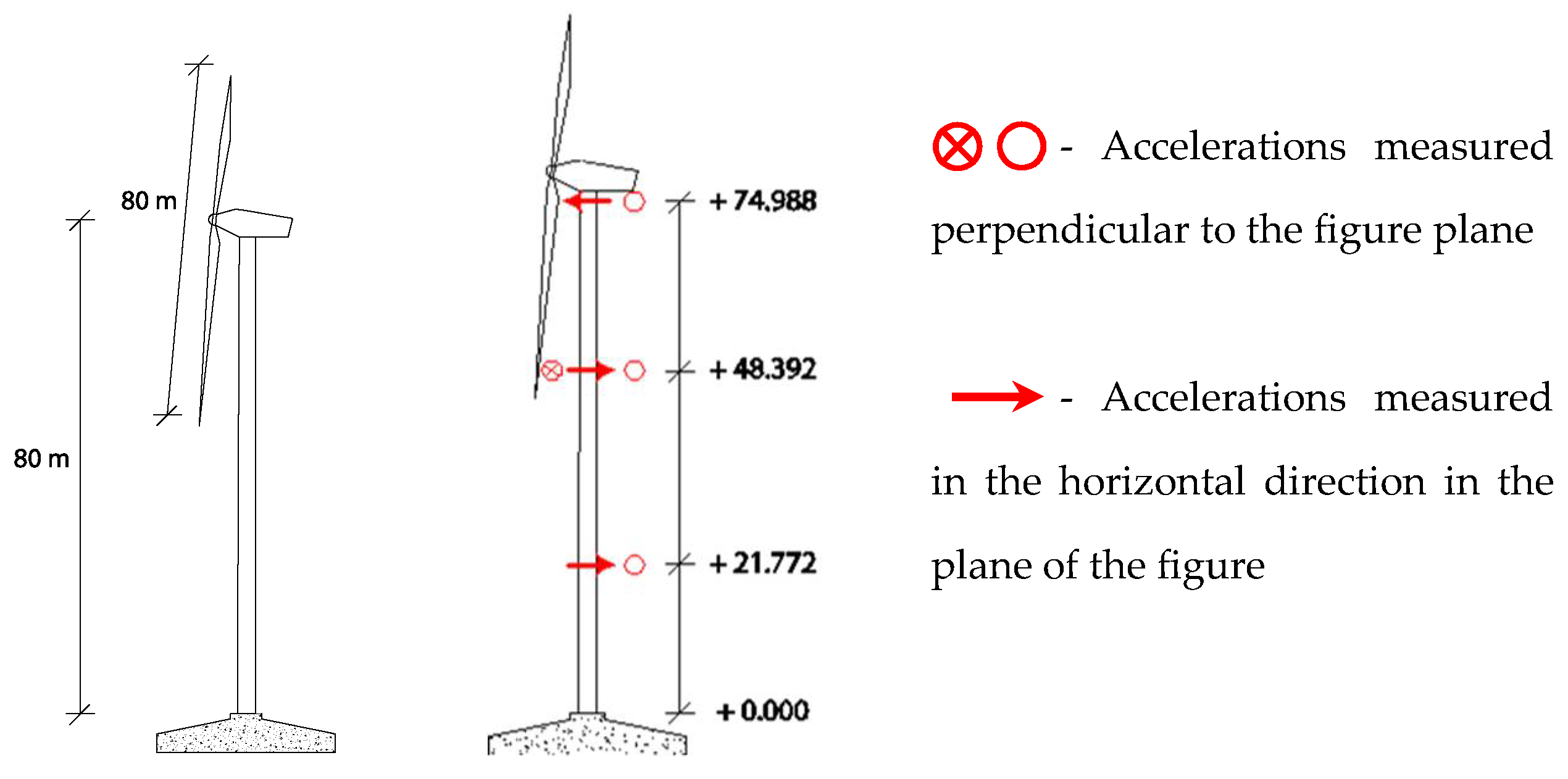

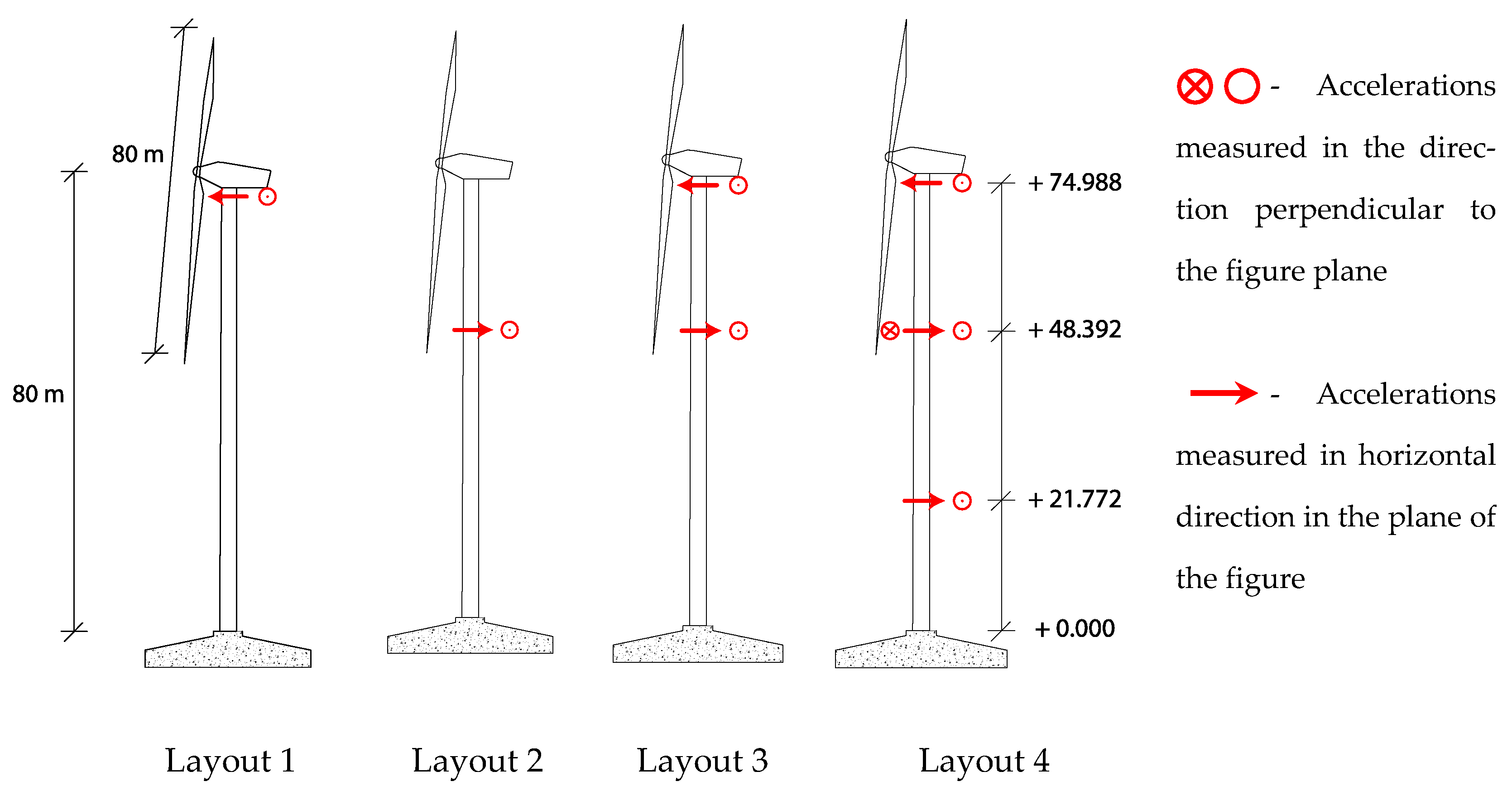
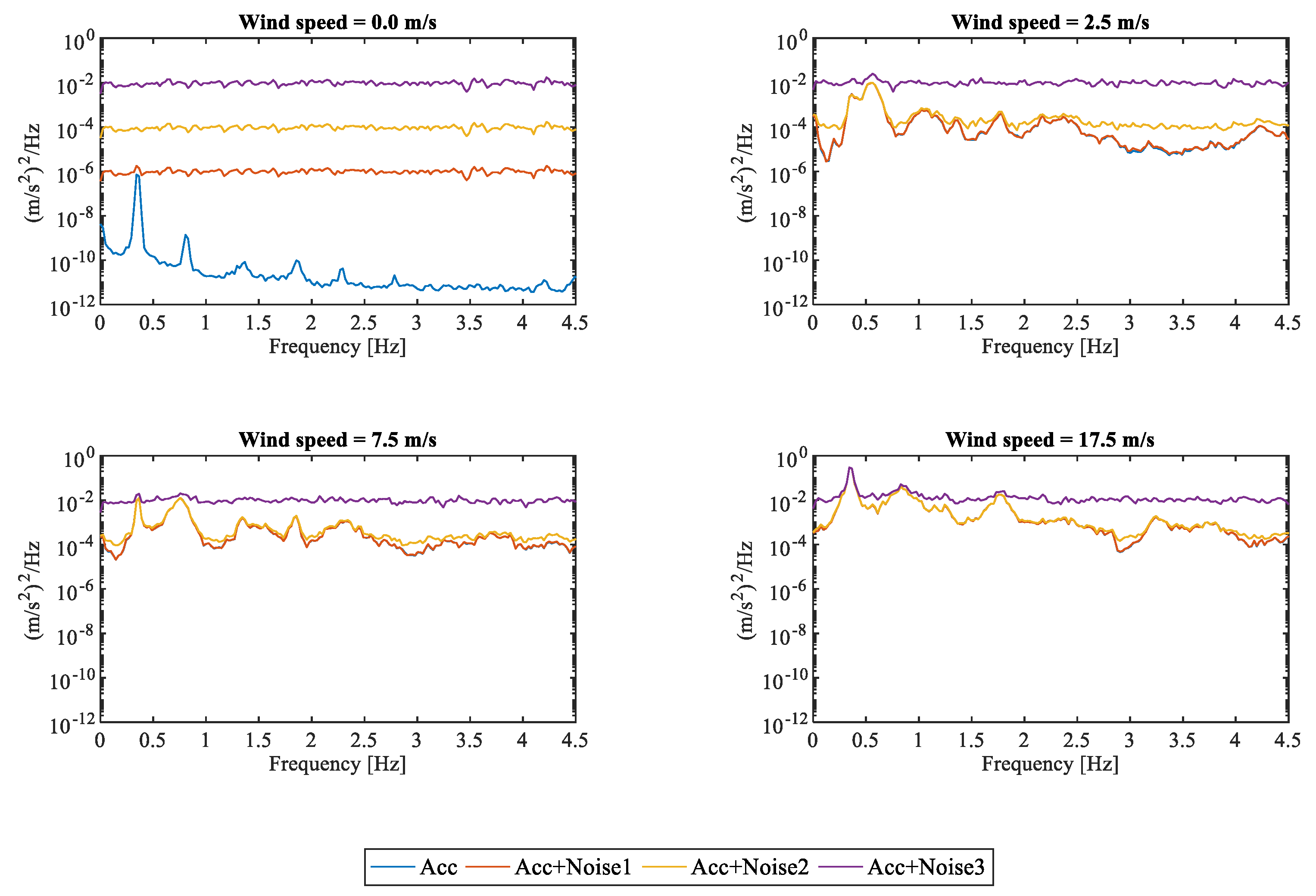
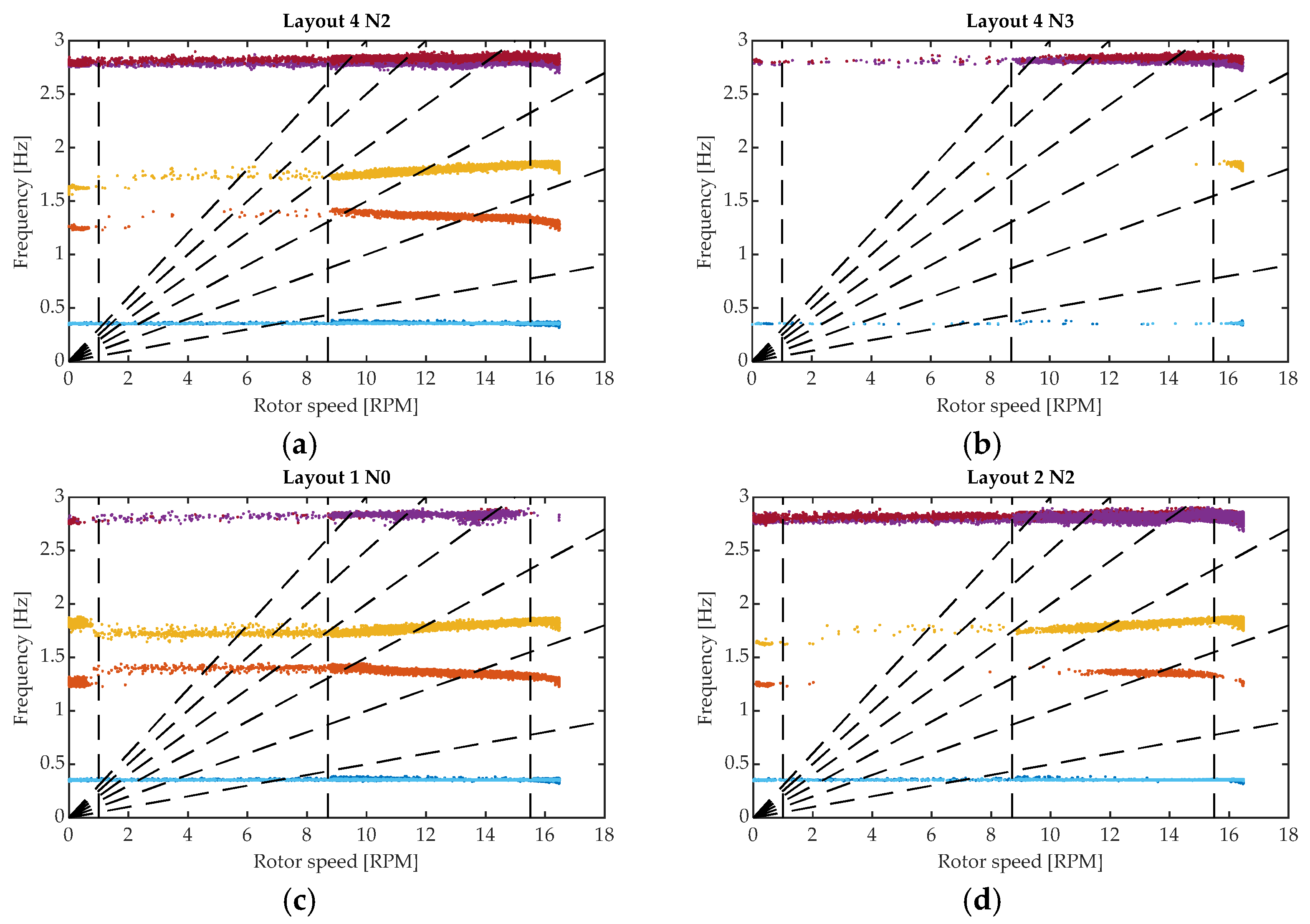
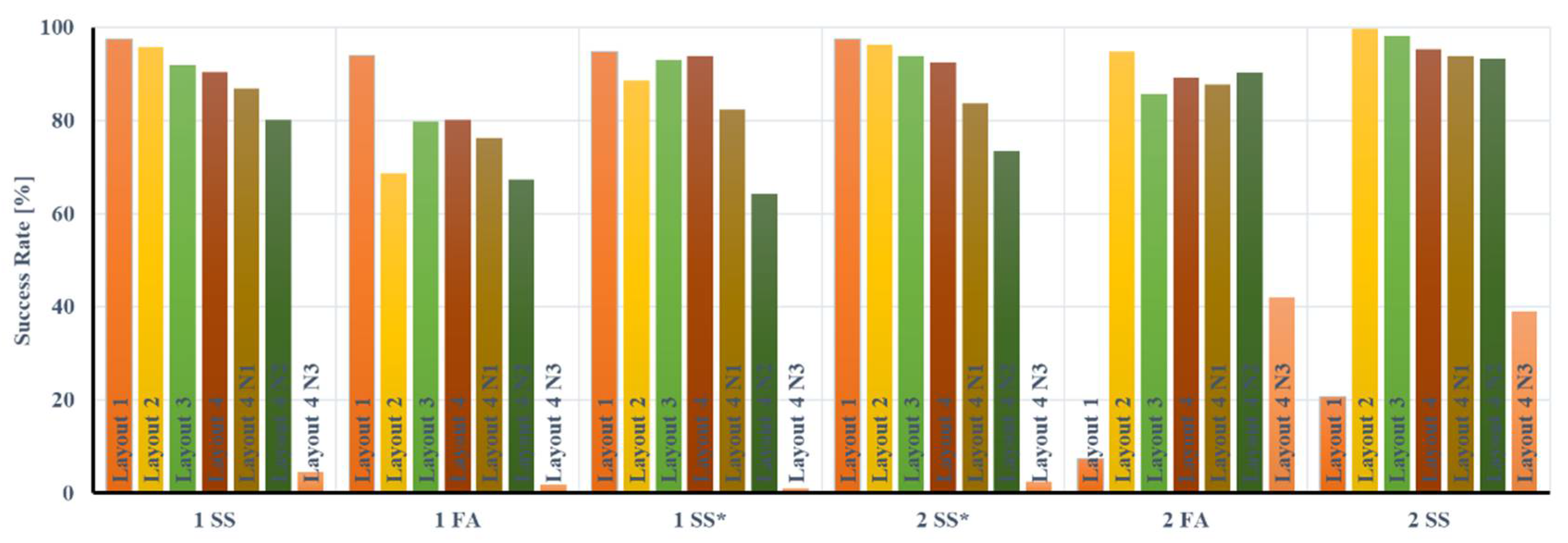

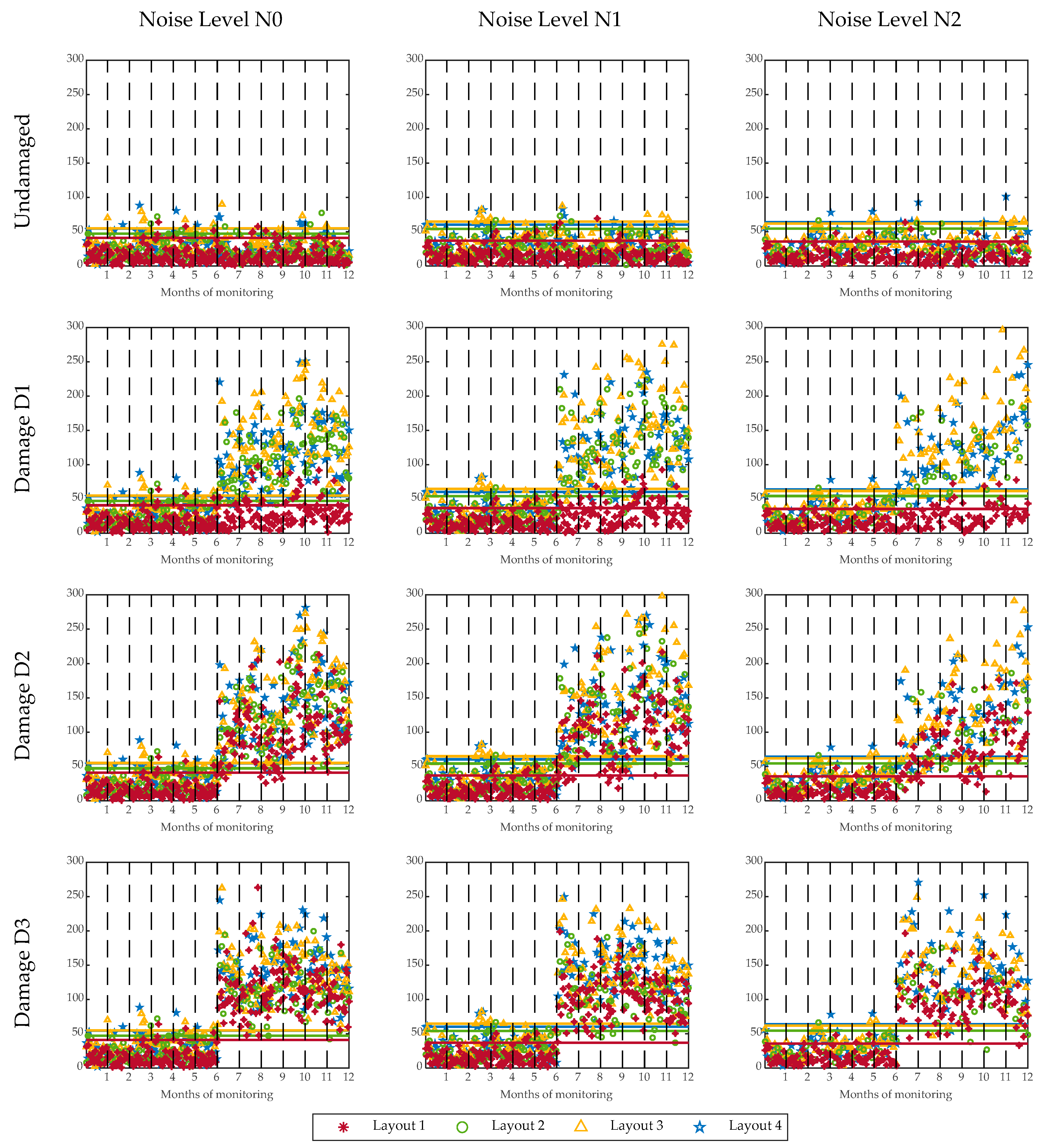
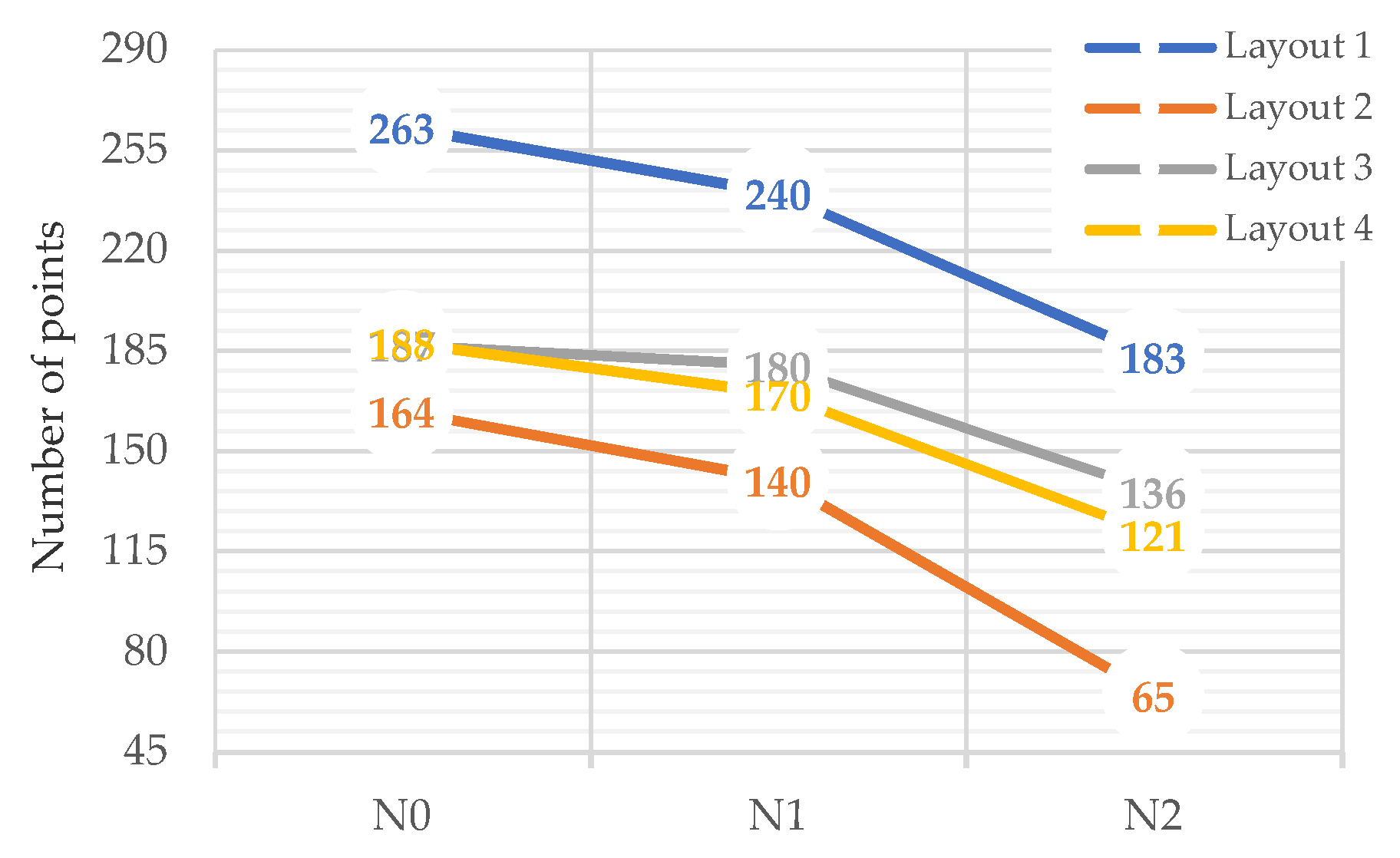
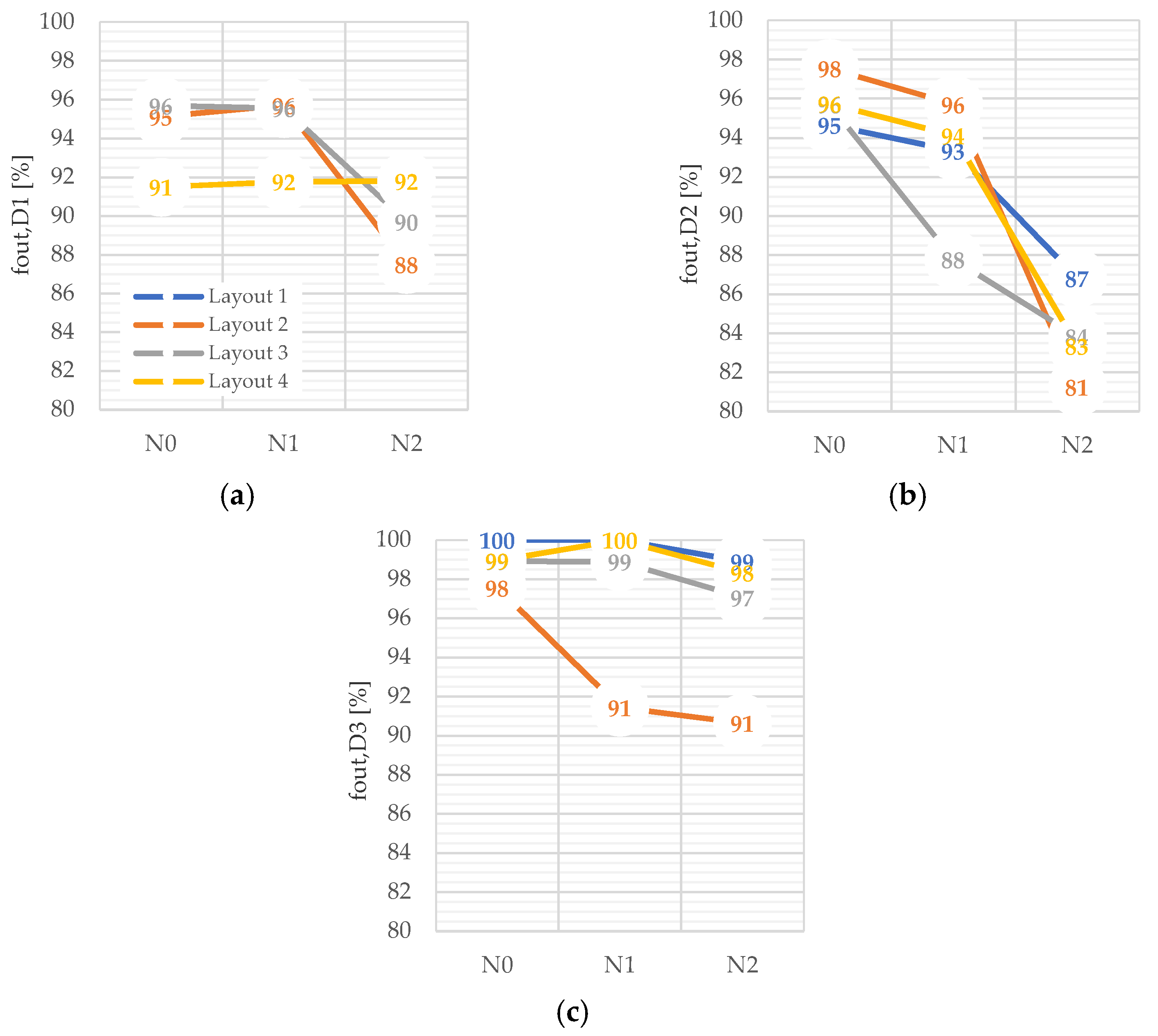

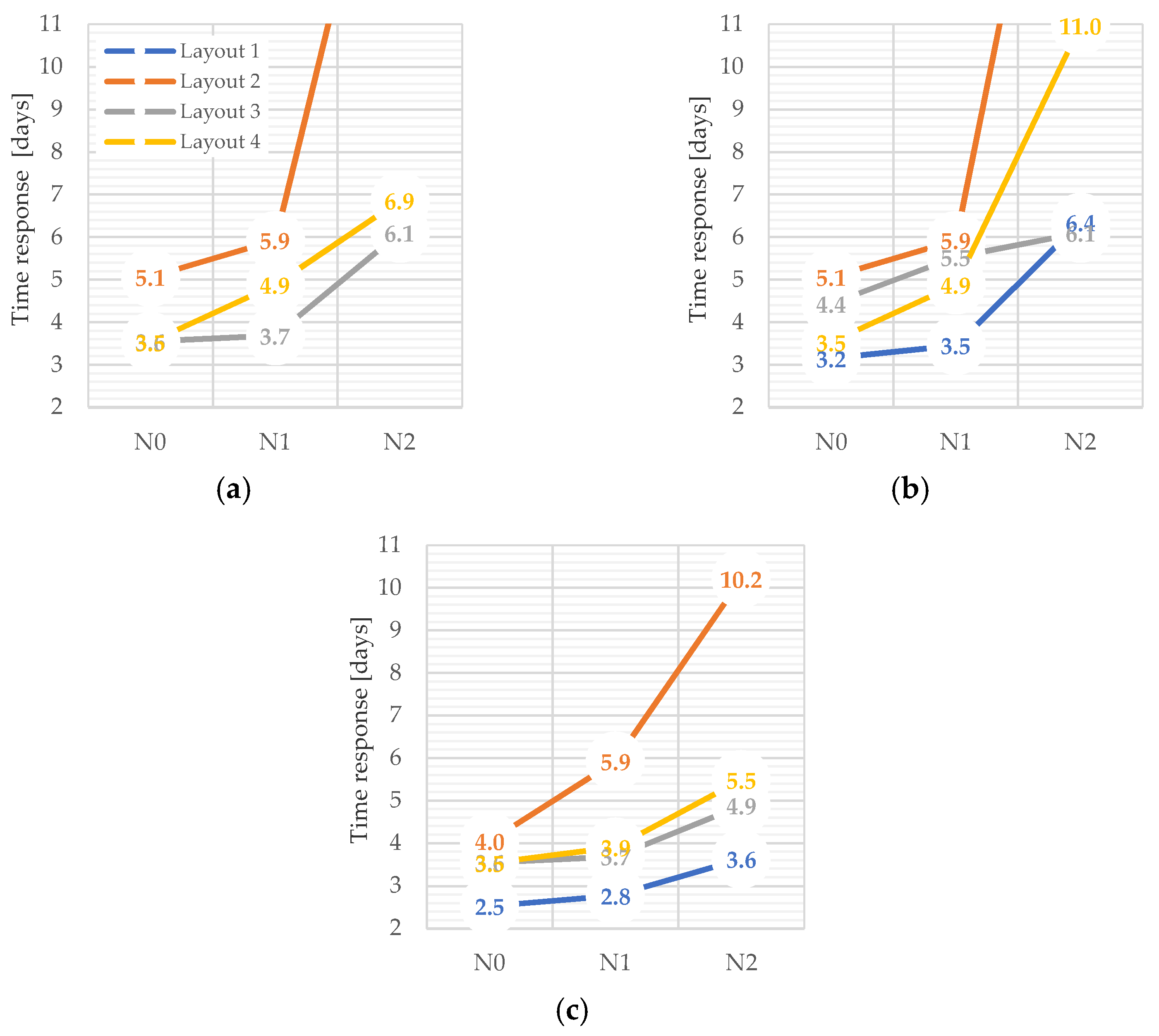
| Mode | SSI-COV | SSI-DATA | p-LSCF | ||||||
|---|---|---|---|---|---|---|---|---|---|
| 1 SS | 0.354 | 81.2 | 0.005 | 0.355 | 84.7 | 0.006 | 0.354 | 80.8 | 0.006 |
| 1 FA | 0.355 | 67.4 | 0.020 | 0.358 | 67.4 | 0.022 | 0.354 | 64.7 | 0.019 |
| 1 SS* | 1.325 | 63.4 | 0.039 | 1.330 | 84.9 | 0.038 | 1.330 | 87.4 | 0.037 |
| 2 SS* | 1.791 | 78.3 | 0.034 | 1.793 | 89.8 | 0.032 | 1.793 | 85.5 | 0.032 |
| 2 FA | 2.792 | 75.8 | 0.009 | 2.789 | 74.0 | 0.009 | 2.796 | 80.1 | 0.006 |
| 2 SS | 2.828 | 83.7 | 0.011 | 2.829 | 60.2 | 0.011 | 2.831 | 85.5 | 0.009 |
| 3FA/3SS | 3.673 | 9.1 | 0.011 | 3.690 | 14.9 | 0.011 | 3.700 | 43.2 | 0.008 |
| 3 SS* | 3.782 | 29.5 | 0.011 | 3.789 | 44.9 | 0.012 | 3.809 | 67.8 | 0.015 |
| 4 FA | 4.236 | 38.3 | 0.017 | 4.266 | 82.3 | 0.019 | 4.276 | 95.1 | 0.019 |
| Modes | |||
|---|---|---|---|
| 1 SS | −0.20 | −0.50 | 0.00 |
| 1 FA | −0.20 | −0.50 | 0.00 |
| 1 SS* | 0.00 | 0.00 | −0.65 |
| 2 SS* | 0.00 | 0.00 | −0.65 |
| 2 FA | −0.40 | −0.24 | 0.00 |
| 2 SS | −0.40 | −0.24 | 0.00 |
| Monitoring Solution | Criterion 1 | Criterion 2 | Criterion 3 | Criterion 4 | Sensors Cost (Approx.) | Final Evaluation | |||||||
|---|---|---|---|---|---|---|---|---|---|---|---|---|---|
| D1 | D2 | D3 | D1 | D2 | D3 | D1 | D2 | D3 | |||||
| Layout 1 | N0 | 263 | - | 95 | 100 | - | 7.0 | 7.9 | - | 3.2 | 2.5 | EUR 3000 |  |
| N1 | 240 | - | 93 | 100 | - | 6.8 | 7.0 | - | 3.5 | 2.8 | EUR 1000 |  | |
| N2 | 183 | - | 87 | 99 | - | 5.2 | 6.5 | - | 6.4 | 3.6 | EUR 400 |  | |
| N3 | - | - | - | - | - | - | - | - | - | - | EUR 200 |  | |
| Layout 2 | N0 | 164 | 95 | 98 | 98 | 5.2 | 6.0 | 5.3 | 5.1 | 5.1 | 4.0 | EUR 3000 |  |
| N1 | 140 | 96 | 96 | 91 | 5.2 | 5.4 | 4.3 | 5.9 | 5.9 | 5.9 | EUR 1000 |  | |
| N2 | 65 | 88 | 81 | 91 | 3.9 | 3.5 | 3.8 | 17.9 | 20.4 | 10.2 | EUR 400 |  | |
| N3 | - | - | - | - | - | - | - | - | - | - | EUR 200 |  | |
| Layout 3 | N0 | 188 | 96 | 96 | 99 | 5.1 | 5.5 | 5.3 | 3.6 | 4.4 | 3.6 | EUR 6000 |  |
| N1 | 180 | 96 | 88 | 99 | 5.1 | 5.1 | 4.9 | 3.7 | 5.5 | 3.7 | EUR 2000 |  | |
| N2 | 136 | 90 | 84 | 97 | 4.7 | 4.4 | 4.6 | 6.1 | 6.1 | 4.9 | EUR 800 |  | |
| N3 | - | - | - | - | - | - | - | - | - | - | EUR 400 |  | |
| Layout 4 | N0 | 188 | 91 | 96 | 98 | 4.7 | 5.4 | 5.8 | 3.5 | 3.5 | 3.5 | EUR 10,500 |  |
| N1 | 170 | 92 | 94 | 91 | 5.1 | 5.5 | 6.0 | 4.9 | 4.9 | 3.9 | EUR 3500 |  | |
| N2 | 121 | 92 | 83 | 91 | 4.2 | 4.2 | 5.0 | 6.9 | 11.0 | 5.5 | EUR 1400 |  | |
| N3 | - | - | - | - | - | - | - | - | - | - | EUR 700 |  | |
 Relative advantage;
Relative advantage;  relative disadvantage;
relative disadvantage;  advantage depends on the circumstances.
advantage depends on the circumstances.Publisher’s Note: MDPI stays neutral with regard to jurisdictional claims in published maps and institutional affiliations. |
© 2021 by the authors. Licensee MDPI, Basel, Switzerland. This article is an open access article distributed under the terms and conditions of the Creative Commons Attribution (CC BY) license (http://creativecommons.org/licenses/by/4.0/).
Share and Cite
Pacheco, J.; Oliveira, G.; Magalhães, F.; Moutinho, C.; Cunha, Á. Vibration-Based Monitoring of Wind Turbines: Influence of Layout and Noise of Sensors. Energies 2021, 14, 441. https://doi.org/10.3390/en14020441
Pacheco J, Oliveira G, Magalhães F, Moutinho C, Cunha Á. Vibration-Based Monitoring of Wind Turbines: Influence of Layout and Noise of Sensors. Energies. 2021; 14(2):441. https://doi.org/10.3390/en14020441
Chicago/Turabian StylePacheco, João, Gustavo Oliveira, Filipe Magalhães, Carlos Moutinho, and Álvaro Cunha. 2021. "Vibration-Based Monitoring of Wind Turbines: Influence of Layout and Noise of Sensors" Energies 14, no. 2: 441. https://doi.org/10.3390/en14020441





